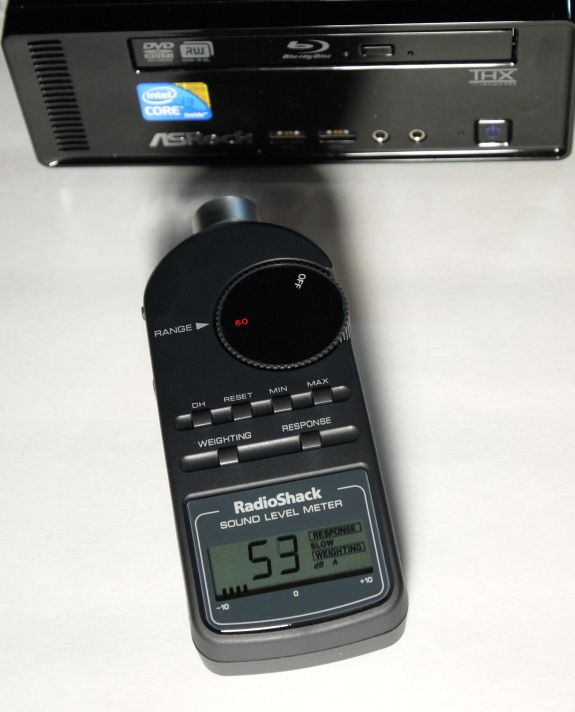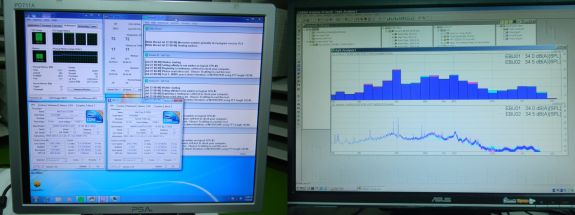ASRock Core 100HT-BD : Bringing HTPCs to the Mainstream Market [UPDATED : Noise Issue]
by Ganesh T S on July 19, 2010 9:34 PM EST- Posted in
- Home Theater
- Arrandale
- ASRock
- Media Streamer
- Core i3
- HTPC
HTPC enthusiasts are rightly concerned about the noise factor, heat and power consumption, ease of usage and many other criteria. We will tackle each of these concerns one by one in this section.
Noise
ASRock claims that the Core 100 HT-BD produces less than 25dB of noise. Under lab testing conditions, such performance is indeed possible. We decided to get hold of one of the sound meters used in setting up home theater speakers to verify whether the claims were true. Being a hobbyist sound meter, it wasn't very sensitive. The measurable sound range was only 50 - 130 dB, and there was a concern that the Core 100 would be too silent for the sound meter to pick up. As it turned out, while running Prime95 at full throttle (100% CPU utilization), the fans kicked in at full speed. The sound meter registered between 53 and 55 dB very close to the unit. [ See UPDATE below for a more practical measurement ]
The fan noise is quite audible if one sits very close to the unit. From 8 ft away, even with the unit in the open, we could barely hear it. Noise, however, is a very subjective issue. We hope the quoted number will help give readers an idea of how noisy the system gets when fully loaded. If the unit is going to be installed inside a cabinet of some sort, the noise factor becomes a non-issue.
UPDATE: One of the reasons we kept our sound detector very close to the unit was because it refused to register any measurement at the usual practical distances. While waiting to get hold of a more sensitive sound meter, we asked ASRock for lab results of sound measurement at full throttle. They were happy to oblige us with the following photographs and video from their anechoic chamber. It appears that the sound level is less than 35dB at a distance of 2 ft. even with all fans in action.
Power Consumption
In order to get an idea of the power consumption numbers, the Prime95 benchmark was let run overnight to keep the system completely loaded for an extended duration. All the four 'cores' of the CPU were pegged at 100% throughout, and we found an average power consumption of less than 48 W. At idle, the system consumed around 18 W.
These type of power consumption numbers have been enabled by ASRock's choice of going in for an Arrandale instead of a Clarkdale platform. This has resulted in a smaller form factor case design for the mini-ITX motherboard. Since there is not much heat to be dissipated, the cooling system is also appropriately small and silent.
Ease of Use
HTPC enthusiasts are concerned about how easy it is for their system to come out of standby. Existence of HDMI handshake issues upon return from standby is also a deal breaker for many. Fortunately, the Core 100 HT-BD has no issues in these two aspects. As long as the AC power adapter is connected to the system, the bundled MCE remote can be used to boot the system (even if the PC had been shut down previously). In order to shorten the boot times, ASRock supplies an Instant Boot utility. Using this, whenver the Core 100 HT-BD is shut down, it boots up once again and shuts down before the power can be safely removed. Upon power up, the boot up is instantaneous. If the user wants to put the PC in sleep mode, ASRock also supplies a Goodnight LED feature in the BIOS, which turns off the bright blue blinking LED in front. The MCE remote can also be used to bring the PC out of sleep mode.
Within Windows, the MCE remote can be made to work with a variety of applications such as XBMC, MediaPortal, MPC-HC and of course, Windows 7 Media Center. Blu Ray players such as PowerDVD and ArcSoft TMT can also be controlled with the help of the MCE remote. For the ideal I/O scenario, one probably needs to purchase a wireless keyboard / mouse combo.
It was seen in an earlier section that the Core 100 HT-BD happened to score quite well in the Anandtech Media Streamer Test Suite. The unit could playback all files using one program or the other, and people expect nothing else from a HTPC. Unfortunately, there is no single unified interface (from XBMC or MediaPortal or any other similar program) which could successfully play back all the files from within. There is definitely an ease of use issue existing here. However, this is not ASRock's fault, and will probably continue to exist on all Clarkdale / Arrandale platforms. Hopefully, projects such as XBMC's DSPlayer mature rapidly to alleviate this problem.













107 Comments
View All Comments
Lostclusters - Sunday, July 25, 2010 - link
I know the review mentioned things like "Perfect Blu-Ray playback with bitstreaming", and "able to play back all Blu-Rays with bitstreaming to the AV receiver", but there is no mention of whether the sound is at 24 bits or 16 bits. I am sure that the same limiting factors as any other PC comes into play. But as I am currently not very well informed on Windows 7, I'd like to see some mention of this in the review. Both with LPCM and native codec.ganeshts - Monday, July 26, 2010 - link
Lostclusters,The bitstreaming is perfect. This means whatever bit resolution is present in the soundtrack is passed on as-is, with no downsampling of any sort.
Its HDMI can pass through Dolby True HD and DTS HD Master Audio up to 192KHz/24-bit , whereas absence of passthrough would mean support for only Dolby or DTS 48KHz/16-bit audio quality.
Even on the other sound channel, i.e, VIA VT2020 codec, there exists support for Blu-ray audio up to 7.1ch 192KHz/24-bit audio with content protection.
Lostclusters - Sunday, July 25, 2010 - link
I forgot to mention that this should be examined not only when playing off a Bluray disk but when playing files off the hard drive as well.Lostclusters - Monday, July 26, 2010 - link
Another item not addressed (maybe in the bench marks) is was how it performed an SD media. I know the screen resolution is locked in at 1080. But how well does it play SD media?ganeshts - Monday, July 26, 2010 - link
Lostclusters,While I agree that the majority of the streams in the test suite were HD (after all, that is the future), we do have 5 - 6 SD streams (evident from the file names).
What you may be looking for is the upscaling capabilities of the GPU / software. I didn't pay much attention to this, but things didn't look horribly wrong. So, I would say that it is good enough to play SD media also. I am unable to think of a metric which will give you a quantitative view of the capability.
Lostclusters - Monday, July 26, 2010 - link
Check out this link at the bottom of the post under the heading of "My Pick of HTPC":http://www.avsforum.com/avs-vb/showthread.php?p=18...
LNCPapa - Monday, July 26, 2010 - link
This device really appeals to me - I was seriously considering going with a Mac Mini + Plex but with the price changes I figured I might as well not give Apple any more my money. By the way - great link post LostCluster - That thread was an awesome read and that guy has done an incredible amount of research.If this device had/would launch at a $500 price point I would purchase it now and ask the wife for forgiveness later.
ganeshts - Monday, July 26, 2010 - link
NewEgg seems to have the non-BluRay model for $580 + shipping:http://www.newegg.com/Product/Product.aspx?Item=N8...
Lostclusters - Monday, July 26, 2010 - link
I have been following Rene's work since his first recommendation on hardware. I have even donated to his work. He is one dedicated individual and has several threads on that forum. Many many good threads there. Chocked full of info.Decaff - Tuesday, July 27, 2010 - link
I really enjoyed reading through this article, as I am myself looking for a media streamer solution. I do, however, have some points of inquiry.First of all, the picture quality testing should be figured out. I have seen television review sites who do regular testing of the picture quality. I know that much of this is a often subjective, but I still think it is paramount that this is analysed, as many home theater enthusiasts are highly sensitive to the picture quality. I do think the use of the HQV test is a good starting point, but I still think subjective measures are in order, as a means of relating the numbers to any percieved loss of quality.
In essense, the people investing in HTPC's of media streamers will probably also have a quality TV-set/projector attached to it. So the framerate issue could naturally be a killer for many enthusiasts, as I know this particular issue has been discussed on many TV forums, where they are very concerned with configuring the TV properly to the correct framerate in order to achieve the right picture quality.
Perhaps an alliance with a site that specialises in reviewing picture quality of TV sets?
Secondly, I think you should be more aware of what software you are using on the machine. Naturally, Anandtech is largely a hardware site, but when dealing with a media streamer/HTPC it is essentially the software that defines the final user experience of the setup. Essentially, if I have just bought a HTPC, I don't want to be pestered with 3 different programs in order for the box to do its job. Rather I (and presumably almost everyone else) wants a nice interface that can handle all the tasks the box it built for, preferably using only the remote control, and the occasional keyboard/mouse when performing tasks that are PC-centric.
So my suggestion is to make a large article with HTPC software, where you look at the features it offers, ease of use, and naturally and in relation to my first point, the output quality of them.
Lastly, I'm really looking forward to seeing some reviews of more dedicated (smaller and cheaped) streamer boxes, such as the WDTV live, A.C. Ryan Playon!HD or the Popcorn machines and naturally also a comparison with the gaming consoles as the Playstation 3 or the Xbox 360 and how they fare in comparison, regarding codec support, and of course in the area of picture quality and ease of use.
These last are at the moment those that interest me the most, as I just want a box that can play my movies from an external HDD or a NAS/Home Server, without all the extra stuff (although it is of course nice to have), and I suspect a great deal of people have similar demands and can use another PC to rip their movies.